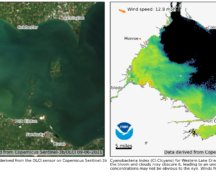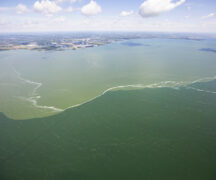Heavier rain than expected for July has increased the severity of the harmful algae bloom in the western basin of Lake Erie.
Scientists from the National Oceanic and Atmospheric Association are increasing the severity of the range to 4.5-5.5 on a scale that has reached just over 10. This would make it about as severe as last year’s bloom.
This new estimate is based on conditions observed on the lake.
“Blooms that do form will move with the wind and change over time; we will provide information on the presence and location of the bloom throughout the summer,” NOAA said.
Earlier this summer at the annual conclave announcing the prediction, researchers said the bloom would be light, about 3.5.
[RELATED: Data & questions flow as annual forecast predicts another smaller harmful algae bloom]
The bloom feed on phosphorus that flows into the lake from the Maumee River Watershed. That’s affected not only by how much phosphorus comes from farm fields and other sources, but how heavy the water flow is.
Early this month, researchers said they didn’t expect much heavier rains than had fallen to date in the summer, but did say that could change their prediction.
The most severe bloom in the past decade was in 2014, when it topped that 10 point scale established in 2010. In 2020 the severity was 3. In 2019 when farmers were not able to plant mst of their acres, the bloom still topped 6 because of the amount of water flowing into the lake. Dr. Laura Johnson, from Heidelberg College who leads a long standing water study of the Maumee, said at the time that this was far lower severity than would be expected given the amount of rain.





